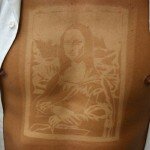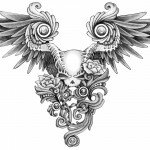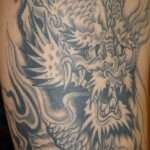Tattoo
May 7, 2007 – 10:38 am
 The art of [[tattoo]] making started in ancient civilization although the earliest records that show evidence were in 2000 BC in ancient Egypt with their paintings in the wall indicating that tattoo was already practiced in their society. It is a very old art form wherein the body is used as canvas. The word tattoo has various etymologies from different languages since it has been practiced by several civilizations for several reasons.
The art of [[tattoo]] making started in ancient civilization although the earliest records that show evidence were in 2000 BC in ancient Egypt with their paintings in the wall indicating that tattoo was already practiced in their society. It is a very old art form wherein the body is used as canvas. The word tattoo has various etymologies from different languages since it has been practiced by several civilizations for several reasons.
The word “tatao†is a Polynesian word meaning “to tap†which precedes the Tahitian word “tatuâ€, which means to mark something. They are thought to be the word origins of the word tattoo. In several groups and religions, tattoo is made an important part of their practice, with each follower having the specific tattoo mark on their body to show his part and authority within the group. Most cultures throughout history have practiced some form of body art, from body piercing to the painting of their bodies.
For the past 150 years, numerous mummified remains have been dug up that are decorated with tattoos. A 5,000 year old frozen but well-preserved body of a Siberian Iceman was discovered in the Alps, having 57 tattoos. A Scythian Chieftain mummy was found to have tattoos of a donkey, a ram, and deer on his body. The Egyptian priestess Amunet, who existed sometime during 2160 to 1994 BC had tattoos on her arms, legs and below the navel. In Japan, clay figurines that were more than 3000 years old were found painted with tattoo like markings.



During the biblical times of the Old Testament, the art of tattoo was considered pagan since it became a form of deity worship. But experts suggest that Moses favored this art as a way to commemorate their deliverance from slavery in Egypt. Roman writers during that time have also reported that slaves and criminals bore marks or tattoos. When Constantine became Roman Emperor in the fourth century, he banned the putting of tattoos on the face, commonly done by convicts, soldiers and gladiators. In the late fifth century, a monk was documented to have a tattoo on his thigh. Procopius of Caesarea, in the sixth century reported that many Christians had tattoos of cross or Christ’s name on their arms. Crusaders, upon arriving in the Holy Land, have a tattoo of a small cross done on their hands or arms to signify their desire for a Christian burial.
Before, tattoos were done as rites of passage, marks of status and rank, signs of religious and spiritual devotion, serves as medal for bravery, a mark of fertility, love, punishment, protection as well as the mark of an outcast, slave and convict. It has also been used to brand Jews in concentration camps during the Holocaust. Sailors from Europe used to have the picture of the crucifixion of Christ tattooed on their backs for protection from flogging since it was considered a crime to defile Christ’s image. Nowadays, they are applied more for cosmetic and aesthetic use and to show their affiliation with a certain group. It is a form of self expression for others. As a cosmetic, it is used as a permanent makeup to enhance the eyes and lips, and cover for skin discolorations.
Sometimes, tattoos made in conspicuous areas in the body, coupled with other body modification can lower the probability of getting decent employment. Although this usually depends on the company rules and regulations since some employers see tattoos as giving an unprofessional appearance. Still in some cultures, having tattoos is viewed to be associated with criminals, and mafia members. For women with tattoos, it is not favorable to them to have it since it denotes them being tramps and other degrading occupation.Before, in some tribal cultures, tattoos are created by cutting the design into the skin and rubbing the wound with ink, ashes or other agents. Some make them by hand tapping the ink into the skin with the use of sharpened sticks, animal bones or needles. In Japan, they still use the traditional method of inserting ink manually using bamboo or steel needles.
Now, the most common method used is the electric tattoo machine, inserting ink into the skin using a group of needles that oscillates 80 – 150 times a second as it rapidly pokes the needles in and out of the skin. This is the most sanitary since the needles used are packaged individually and are disposable.
The first tattoo machine was invented by Samuel O’Reilly in 1891 which was patterned on the rotary technology of the electric engraving device made by Thomas Edison. Modern tattoo machines use electromagnetic coils which was first discovered by Thomas Riley and improved by Alfred Charles South in 1899.
The pigments and dyes used before were very much different from the ones being used now. They used to be from a mixture of natural ingredients and were limited to only the colors that they can find in nature. But now, there are a wide range of dyes and pigments to choose from, made from inorganic materials like iron oxides, azo dyes, and quinoline derivatives, as well as dyes made from ash and other mixtures. Iron oxides are frequently used in cosmetic tattooing. Just recently, the use of a blacklight reactive pigment is emerging in popularity as the chameleon tattoo ink.
A tattoo studio should be properly equipped, with the necessary sanitary and safety equipment and bio-hazard precautions for the instruments used. A tattoo artist should practice proper hygiene especially when dealing with clients since this procedure is prone to contamination. Cleanliness is a major consideration in these places since a small mistake may lead to infections and complications. Minors are required to present parental consent and those with skin conditions, pregnant, and with other illness that may contraindicate the pigments use or needles are discouraged from getting tattoos.
Getting tattoos will take about fifteen minutes to several hours and multiple sessions, depending on the size and intricacies of the design of the tattoo. After a session, recovery time is usually for twenty four hours. They usually do not allow contact with water and to avoid exposure until the wounds heal.
Tattoos are usually a fun way of expression one’s freedom. It is not for the faint hearted although it may also be used as a test of strength. Just remember to practice care and safety when trying out these kinds of ideas or else it might cause more harm than good.
4 Responses to “Tattoo”
nice web
By tattoo on Dec 10, 2009
Very informative; thank you!
By asdf on Sep 15, 2010
Kushites wich is modern day ethiopia an north somalia known as somaliland djbouti sudan eritrea 1st had this for a sign of beauty for womeen an it was not permenant until the egyptians made it so dats y all the modern day art of tattoes an symbols look like ancient egyptian an we gave birth. To egyptians so stop hiding all the facts bcos we can show ppl with tattoes dat are very dangerous dat do magic an increadable things very quick which why that land has never been conqord
By ahmed on May 27, 2011
Who wrote this?
By RSJ on Feb 3, 2012